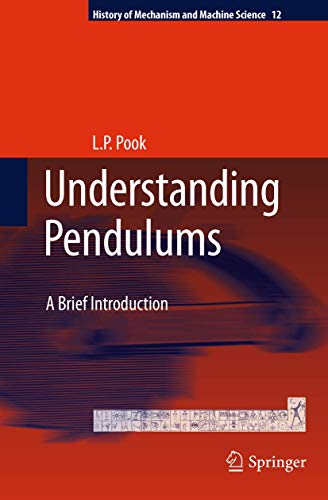
Understanding Pendulums | A Brief Introduction | L. P. Pook | Taschenbuch | History of Mechanism and Machine Science | Paperback | xvi | Englisch | 2013 | Springer Netherland | EAN 9789400736344 - Taschenbuch
2013, ISBN: 9789400736344
[ED: Taschenbuch], [PU: Springer Netherland], Despite their apparent simplicity, the behaviour of pendulums can be remarkably complicated. Historically, pendulums for specific purposes ha… Mehr…
| booklooker.de |

Understanding Pendulums: A Brief Introduction (History of Mechanism and Machine Science, Band 12) - Taschenbuch
2013, ISBN: 9789400736344
Springer, Taschenbuch, Auflage: 2011, 152 Seiten, Publiziert: 2013-07-15T00:00:01Z, Produktgruppe: Buch, Hersteller-Nr.: biography, 0.49 kg, Verkaufsrang: 765, Maschinenbau, Ingenieurwiss… Mehr…
| amazon.de |

Understanding Pendulums: A Brief Introduction (History of Mechanism and Machine Science) - Taschenbuch
2013, ISBN: 9400736347
[EAN: 9789400736344], Gebraucht, wie neu, [PU: Springer], Like New, Books
| AbeBooks.de Mispah books, Redhill, SURRE, United Kingdom [82663586] [Rating: 4 (von 5)] NOT NEW BOOK. Versandkosten: EUR 23.49 Details... |

2013, ISBN: 9400736347
[EAN: 9789400736344], Neubuch, [PU: Springer], PRINT ON DEMAND Book; New; Fast Shipping from the UK., Books
| AbeBooks.de Ria Christie Collections, Uxbridge, United Kingdom [59718070] [Rating: 5 (von 5)] NEW BOOK. Versandkosten: EUR 1.75 Details... |

2013, ISBN: 9400736347
[EAN: 9789400736344], Neubuch, [PU: Springer], pp. 152, Books
| AbeBooks.de Books Puddle, New York, NY, U.S.A. [70780988] [Rating: 4 (von 5)] NEW BOOK. Versandkosten: EUR 8.17 Details... |


Understanding Pendulums | A Brief Introduction | L. P. Pook | Taschenbuch | History of Mechanism and Machine Science | Paperback | xvi | Englisch | 2013 | Springer Netherland | EAN 9789400736344 - Taschenbuch
2013, ISBN: 9789400736344
[ED: Taschenbuch], [PU: Springer Netherland], Despite their apparent simplicity, the behaviour of pendulums can be remarkably complicated. Historically, pendulums for specific purposes ha… Mehr…

Pook, L.P.:
Understanding Pendulums: A Brief Introduction (History of Mechanism and Machine Science, Band 12) - Taschenbuch2013, ISBN: 9789400736344
Springer, Taschenbuch, Auflage: 2011, 152 Seiten, Publiziert: 2013-07-15T00:00:01Z, Produktgruppe: Buch, Hersteller-Nr.: biography, 0.49 kg, Verkaufsrang: 765, Maschinenbau, Ingenieurwiss… Mehr…

Understanding Pendulums: A Brief Introduction (History of Mechanism and Machine Science) - Taschenbuch
2013
ISBN: 9400736347
[EAN: 9789400736344], Gebraucht, wie neu, [PU: Springer], Like New, Books

2013, ISBN: 9400736347
[EAN: 9789400736344], Neubuch, [PU: Springer], PRINT ON DEMAND Book; New; Fast Shipping from the UK., Books
2013, ISBN: 9400736347
[EAN: 9789400736344], Neubuch, [PU: Springer], pp. 152, Books
Bibliographische Daten des bestpassenden Buches
| Autor: | |
| Titel: | |
| ISBN-Nummer: |
Detailangaben zum Buch - Understanding Pendulums: A Brief Introduction (History of Mechanism and Machine Science, Band 12)
EAN (ISBN-13): 9789400736344
ISBN (ISBN-10): 9400736347
Gebundene Ausgabe
Taschenbuch
Erscheinungsjahr: 2013
Herausgeber: Springer
152 Seiten
Gewicht: 0,240 kg
Sprache: Englisch
Buch in der Datenbank seit 2008-04-28T01:44:18+02:00 (Berlin)
Detailseite zuletzt geändert am 2023-10-31T13:02:20+01:00 (Berlin)
ISBN/EAN: 9789400736344
ISBN - alternative Schreibweisen:
94-007-3634-7, 978-94-007-3634-4
Alternative Schreibweisen und verwandte Suchbegriffe:
Autor des Buches: pook
Titel des Buches: brief history, pendulum, history mechanism and machine science, understanding pendulums brief introduction
Daten vom Verlag:
Autor/in: L.P. Pook
Titel: History of Mechanism and Machine Science; Understanding Pendulums - A Brief Introduction
Verlag: Springer; Springer Netherland
136 Seiten
Erscheinungsjahr: 2013-07-15
Dordrecht; NL
Gedruckt / Hergestellt in Niederlande.
Sprache: Englisch
106,99 € (DE)
109,99 € (AT)
118,00 CHF (CH)
POD
XVI, 136 p.
BC; Hardcover, Softcover / Technik/Maschinenbau, Fertigungstechnik; Maschinenbau; Verstehen; pendulum; Engineering Mechanics; Physics and Astronomy; History of Science; Mathematics; Technology and Engineering; Life Sciences; Mathematik und Naturwissenschaften; Geschichte der Naturwissenschaften; Mathematik; Ingenieurswesen, Maschinenbau allgemein; Biowissenschaften, allgemein; BB; EA
Despite their apparent simplicity, the behaviour of pendulums can be remarkably complicated. Historically, pendulums for specific purposes have been developed using a combination of simplified theory and trial and error. There do not appear to be any introductory books on pendulums, written at an intermediate level, and covering a wide range of topics. This book aims to fill the gap. It is written for readers with some background in elementary geometry, algebra, trigonometry and calculus. Historical information, where available and useful for the understanding of various types of pendulum and their applications, is included.
Perhaps the best known use of pendulums is as the basis of clocks in which a pendulum controls the rate at which the clock runs. Interest in theoretical and practical aspects of pendulums, as applied to clocks, goes back more than four centuries. The concept of simple pendulums, which are idealised versions of real pendulums is introduced. The application of pendulums to clocks is described, with detailed discussion of the effect of inevitable differences between real pendulums and simple pendulums. In a clock, the objective is to ensure that the pendulum controls the timekeeping. However, pendulums are sometimes driven, and how this affects their behaviour is described. Pendulums are sometimes used for occult purposes. It is possible to explain some apparently occult results by using modern pendulum theory. For example, why a ring suspended inside a wine glass, by a thread from a finger, eventually strikes the glass. Pendulums have a wide range of uses in scientific instruments, engineering, and entertainment. Some examples are given as case studies.
Indexed in the Book Citation Index– Science (BKCI-S)
Preface.- Notation.- 1 Introduction.- References.- 2 Simple Pendulums.- 2.1 Introduction.- 2.2 Simple Harmonic Motion.- 2.3 Analysis of a Simple Rod Pendulum.- 2.3.1 Acceleration due to Gravity.- 2.3.2 Accelerations of a Simple Rod Pendulum.- 2.3.3 Potential and Kinetic Energy of a Simple Rod Pendulum.- 2.3.4 Circular Error of a Simple Rod Pendulum.- 2.3.5 Effect of the Earth’s Curvature.- 2.4 Analysis of a Simple String Pendulum.- 2.5 Spherical Rod Pendulum.- References.- 3 Variations on Simple Pendulums.- 3.1 Introduction.- 3.2 Compound Pendulum.- 3.3 Double Rod Pendulum.- 3.4 Blackburn Pendulum.- 3.5 Bifilar Pendulum.- 3.6 Rotating Simple Rod Pendulum.- 3.7 Quadrifilar Pendulum.- 3.7.1 Dual String Pendulum.- 3.8 Trapezium Pendulum.- 3.8.1 Dual Rod Pendulum.- 3.9 Double String Pendulum.- References.- 4 Pendulum Clocks.- 4.1 Introduction.- 4.2 Pendulum Quality Q.- 4.2.1 Damped Simple Harmonic Motion.- 4.2.2 Definition of Q.- 4.3 Buoyancy.- 4.4 Suspensions and Modes of Oscillation.- 4.4.1 Spring Suspensions.- 4.4.2 Pivot Suspensions.- 4.4.3 Knife Edge Suspensions.- 4.5 Effects of Escapements.- 4.6 Reduction of Effects of Circular Error.- References.- 5 Driven Pendulums.- 5.1 Introduction.- 5.2 Random Process Theory.- 5.2.1 Bandwidth.- 5.3 Driven Damped Simple Harmonic Motion.- 5.3.1 Periodic Driving.- 5.3.2 Random Driving.- 5.4 Horizontal Driving of Pendulums.- 5.4.1 Periodic Driving.- 5.4.2 Random Driving.- 5.5 Occult Uses of Pendulums.- References.- 6 Scientific Instruments.- 6.1 Introduction.- 6.2 Kater’s Pendulum.- 6.3 Newton’s Cradle.- 6.3.1 Modes of Oscillation.- 6.3.2 Theoretical Analysis.- 6.4 The Foucault Pendulum.- 6.4.1 Essential Features.- 6.4.2 Pumping.- 6.4.3 Motions of the Bob.- 6.5 Charpy Impact Testing Machine.- References.- 7 Engineering.- 7.1 Introduction.- 7.2 WattSteam Governor.- 7.3 Cable Car.- 7.4 Tension Leg Platform.- References.- 8 Entertainment.- 8.1 Introduction.- 8.2 Child’s Swings.- 8.2.1 Pumping of Child’s Swings.- 8.3 Child’s Rocking Horse.- 8.4 Pendulum Harmonographs.- 8.5 Harmonograms and Pendulum Harmonographs.- 8.5.1 Lissajous Figures.- 8.5.2 Circular Harmony Curves.- 8.5.3 Miscellaneous Harmonograms.- 8.5.4 Some Practical Considerations.- References.- Index.
From the reviews:
“The present volume is a more modest contribution and is essentially an introduction to the topic. … for a mathematically inclined audience, this is a nice book, introducing the more technological issues associated with the pendulum in an interesting way. The author uses elementary mathematics throughout, and accessible language. … this booklet is an original and worthwhile addition to the literature. … it is an ideal introduction to the fascinating world of the pendulum from the perspective of a professional engineer. I enjoyed reading it.” (Giuseppe Saccomandi, Mathematical Reviews, August, 2013)
Despite their apparent simplicity, the behaviour of pendulums can be remarkably complicated. Historically, pendulums for specific purposes have been developed using a combination of simplified theory and trial and error. There do not appear to be any introductory books on pendulums, written at an intermediate level, and covering a wide range of topics. This book aims to fill the gap. It is written for readers with some background in elementary geometry, algebra, trigonometry and calculus. Historical information, where available and useful for the understanding of various types of pendulum and their applications, is included.
Perhaps the best known use of pendulums is as the basis of clocks in which a pendulum controls the rate at which the clock runs. Interest in theoretical and practical aspects of pendulums, as applied to clocks, goes back more than four centuries. The concept of simple pendulums, which are idealised versions of real pendulums is introduced. The application of pendulums to clocks is described, with detailed discussion of the effect of inevitable differences between real pendulums and simple pendulums. In a clock, the objective is to ensure that the pendulum controls the timekeeping. However, pendulums are sometimes driven, and how this affects their behaviour is described. Pendulums are sometimes used for occult purposes. It is possible to explain some apparently occult results by using modern pendulum theory. For example, why a ring suspended inside a wine glass, by a thread from a finger, eventually strikes the glass. Pendulums have a wide range of uses in scientific instruments, engineering, and entertainment. Some examples are given as case studies.
Indexed in the Book Citation Index– Science (BKCI-S)No competitive book available: there are no books treating this subject at this level Subject of interest to wide readership Accessible writing style
Weitere, andere Bücher, die diesem Buch sehr ähnlich sein könnten:
Neuestes ähnliches Buch:
9789400714144 Understanding Pendulums (L.P. Pook)
< zum Archiv...


